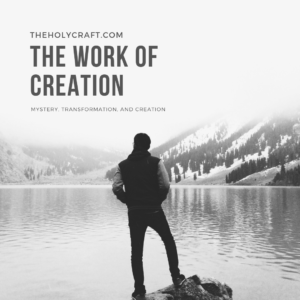Here at The Holy Craft, we want to bring you top quality content that makes a difference in your life as you craft your own faith. We will begin a week-long series called The Work of Creation. In it, we will dig deeply into the Creation stories from the Bible to wrestle meaning and encouragement. Each day, there will be another aspect of the two creation stories available. We hope you enjoy this journey!
If you read the beginning of the Bible carefully, you may notice that Genesis 1 and Genesis 2 are two completely different creation stories. Throughout the years, people have tried to put them together saying that the second (the story of Adam and Eve in the Garden) is just a detailed picture of the first. But understanding that they were different stories of creation written for different communities with different images of God will help us open our minds to a new appreciation for them.

Let’s start with a brief summary of the two stories:
In Genesis 1, we have the famous “Let there be” statements. Think “Let there be light.” The first chapter of Genesis reads like poetry, in part because it is poetry. Each stanza of the poem is another “day” of creation that begins with “And God said, ‘Let there be…” Each day of creation ends with God’s observation that it was good. This repetitive pattern goes for 6 days. On the 6th day, God creates humankind. It is this pattern that people interpret literally as a 7 day creation, but these days and the creation within them are not intended to be read literally.
According to the New Revised Standard Version (our favorite translation here at The Holy Craft), God creates humankind in God’s image. But curiously, it says, “Let us make humankind in our image.” When we compare the images of God in these two passages, we will come back to this interesting translation.
At the end of the 6th day, God looks at creation that includes humans and says that it is very good, an upgrade from the daily statement of goodness. On the final day, God rests, setting into motion a sabbath pattern for the world in which rest in integrated into the creative world.
In Genesis 2, we have a very different picture of creation in which God is walking around a garden. God is like a gardener in this story and takes dirt to for the first person. It is this person who we call Adam, yet the Hebrew word used here is adam, which means dirt creature. At this point, the dirt creature has no gender.
Then God decides the dirt creature needs a partner, so God tries out some different creatures that could be potential partners. This is where we find God creating all kinds of animals. None are found to be suitable partners, so God puts the dirt creature to sleep and takes a rib to create a parter. It is at this time that we have God creating them into male and female. Here is our introduction to Adam and Eve. Adam and Eve then go on to have children, as they are told to be fruitful and multiply.
We won’t get in to what happens next for a few days so that we can spend time digging into these two stories and ask what importance they have for us today as we craft our faith.
The main difference between these two stories is the way God is portrayed. In the first story, God is portrayed as being out there. The theological word for this is transcendent. This is the idea that God is big enough to be outside of the world and tell everything that comes to be what to do. This is a very powerful image of God and has proven to be quite popular. However, it has its pitfalls. With all of that power, God can easily be turned into a tyrant (See 4 toxic theologies). God’s transcendence and power has to be balanced with nearness, intimacy, and absolute love. And this is the image of God we get in the second story. God is right here. In the second story, we get a God who is walking around with humans. We get a God who is like a gardener, getting her hands dirty.
Right at the beginning of this tradition, we get a disagreement about God. We get two different pictures of God. What if these two stories being placed beside each other are to help us see that there is more than one way to see God? As crafters, so many of us have been hurt by faith communities that have proclaimed one way to see God. We’ve seen firsthand that if you don’t prescribe to that way of seeing or believing, then you are kicked out and told that you do not belong. What if these two creation stories are there for you to be empowered? What if they are empowering you to use your imagination in how you see God? God isn’t just out there. God is here too. God isn’t just here. God is out there too.
Isn’t it great news that God can’t be contained by one place, or one word, or one story?
These two stories were created as stories. They were not created to be historical or biological records. Too much harm has been done in their name as people has misidentified them as historical records. This week, we will unpack these stories on a deeper level to help us all craft a more meaningful faith. Join us on this journey!
2 thoughts on “Series: The Work of Creation”
Comments are closed.